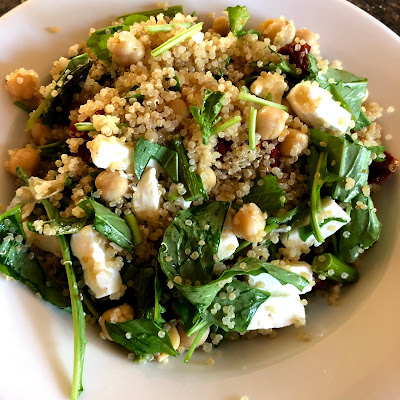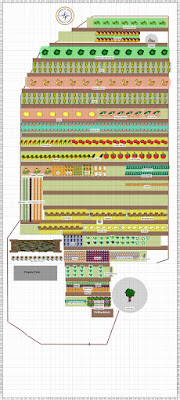For just the second time in a decade, we've purchased bulk beef from a local farm. I'll be honest, with the ongoing pandemic I'm glad we have freezers full of meat (and garden-preserved veggies) to help us avoid trips to the grocery store while we continue to spend most of our time at home over the winter.
This post is to help demystify the bulk meat purchasing process (see also my post about buying a whole hog).
We purchased our beef from the same farm that raised our pork and chickens. I contacted them in May and placed a deposit on a quarter of one of their Black Angus steers. They told me the next beef would be available in October. This farm offers mixed quarters, rather than designated front and rear quarters. This means that we're basically sharing half of the steer with someone else, allowing each of us to have some of the cuts from both the front and rear quarter (so we can get both brisket and sirloin).
On September 19 the farm called with news the steer would be butchered on September 24, and I provided my cutting instructions over the phone (approximate size of the roasts, thickness of steaks, number of steaks per package, size of ground beef packages, what goes into ground and stew meat, if we want any non-grocery cuts, etc.). Beef is best if it hangs (ages in a cooler) before being cut into smaller pieces, so we didn't receive our cuts until October 10.
And yesterday, we received 3 large cardboard boxes full of packaged meat, delivered right to our door (I love that about this farm). Buying meat this way makes me feel good about supporting our local economy. The steer grazed and lived a life on pasture 20 minutes from our house, and it was slaughtered and butchered by a full-service butcher 15 minutes from our house.
What We Got From Our Quarter Beef
The farmer delivered the boxes right into our garage, where we had a folding table, scale, Sharpie, and inventory sheet set up in front of our auxiliary freezer (a 3/4 size upright freezer). I like to weigh and inventory each cut of meat for record keeping. Not only does it allow me to write posts like this, but I can also keep track of what's in our freezer without digging around in it constantly.
The first box I opened was all ground beef. That's a lot of taco nights.
Here's the full inventory.
Trim Cuts
- 44 pounds of ground beef
- 7 packages of stew meat, 9 pounds total
- 1 package spare ribs, 1.5 pounds
Steak
- 7 rib-eye steaks, 10.5-14.5 ounces each
- 7 t-bone steaks, 18-25 ounces each
- 4 bone-in sirloin steaks, 24-38 ounces each (!)
- 3 top round steaks, 19-27 ounces each
- 1, 1-pound flank steak
Roasts
- 2 arm roasts, 3-3.5 pounds each
- 2 briskets, 2.5 pounds each
- 6 chuck roasts, 2.5-4 pounds each
- 1, 3-pound rump roast
- 1, 4-pound sirloin tip roast
In total, that's 118.5 pounds of beef. You could easily alter the composition of this order by having the steaks cut thinner (we cut ours thick), or putting more of the roast meat into either the ground beef or the stew meat.
Extras
As always, I also requested some of the "extras." The farmer was surprised that she received more requests for organ meat than normal, so I asked for some things that I wasn't able to get because we were sharing this steer.
- Kidney (10 oz)
- Liver (3.5 lbs)
- Neck Bones (3 lbs)
- Soup Bones (4.75 lbs)
- Suet (5.5 lbs)
The liver is for the cats. The kidney may be too, unless I get adventurous. T bones are for stock, and I hope to use the suet either in a
traditional British recipe when I'm feeling adventurous, or render it into tallow that I can use for frying.
Once unpacked, this fit easily in our auxiliary freezer. The bottom drawer is filled with ground beef, and most of the cuts are on the bottom shelf (there's a plastic container with more cuts on the shelf above it, but it will fit on the bottom shelf if I force it) as well as the lower two shelves in the door.
Looking back on our
first bulk beef order in 2012, I'm struck by the difference in breeds of steers. Back then, we shopped around for "the best value." That means what we ended up purchasing was a Jersey steer raised mostly on pasture. These aren't steers that are bred for meat; they're the male offspring of a dairy cow (which obviously can't be raised for milking). So not only was it cheaper, but it was smaller. Our half steer back then provided just under 150 lbs of meat, and the t-bone steaks were 1/3 to 1/4 the size of what we received this year. Our recent purchase was a Black Angus steer, which is bred for beef.
Quarter Beef Cost Comparison
Some people purchase beef and other meat in bulk to save money. Although there is some cost savings, that's not our main motivation. We want to support a local food system based on natural practices, and enjoy the security and convenience of a fully-stocked freezer. Yet, the cost comparison is helpful for folks trying to decide if they want to make their own purchase, so I'm including it.
What We Paid
Our quarter beef was priced at $4.60 per pound hanging weight, and our quarter hung at 213.75 pounds. We also paid $173.38 to the butcher in processing fees. So, our total cost for the quarter beef was $1,156.63. Divide that by the 118.5 pound of grocery store cuts, and we paid $9.76 per pound.
What It's Worth
The meat we purchase is raised on pasture, so the best comparison I can find is the
USDA Monthly Grass Fed Beef Report. After consulting the September report, we barely came out ahead when comparing our grocery store cuts. We paid about $192 less than we would have for all the same cuts at retail, thanks in large part to the steaks we received. I should note, however, that the listed range for a quarter of grass fed beef is $5.75 - $11.75 per pound, so our farm is charging well below average.
Why We'll Keep Purchasing Bulk
Interestingly, we would probably only buy steaks 2-3 times per year if we didn't buy beef in bulk, so we probably spend more money on meat when we purchase it this way than if we were to buy directly from the store. However, grass fed beef isn't always available in our local grocery store (especially cuts beyond ground beef) and it is often trucked in from around the country, processed at the same large meatpacking plants as conventional beef. I'm much happier buying my meat directly from a farmer, and it diversifies my eating habits in the process.
If you live in the Madison, WI area, check out
Anisoptera Acres. They're an off-grid family farm that raises pork, beef, and chicken on pasture. In addition to bulk purchases like the ones we made, they also offer single cuts of meat and homemade honey with
free home delivery on orders over $40.

















